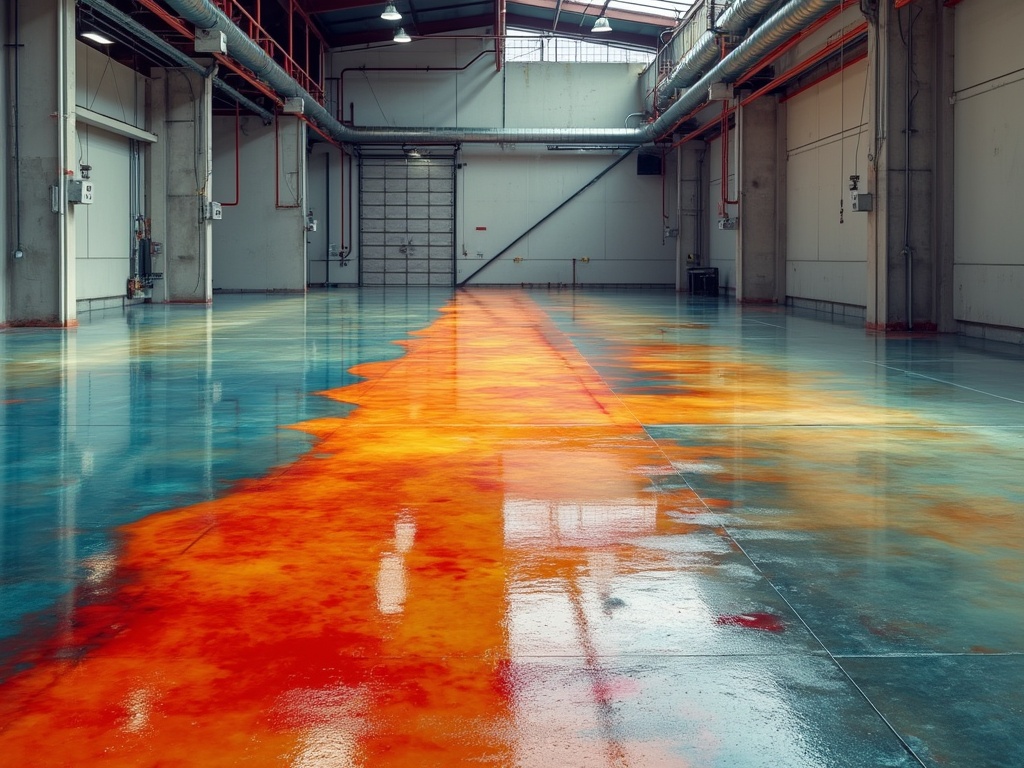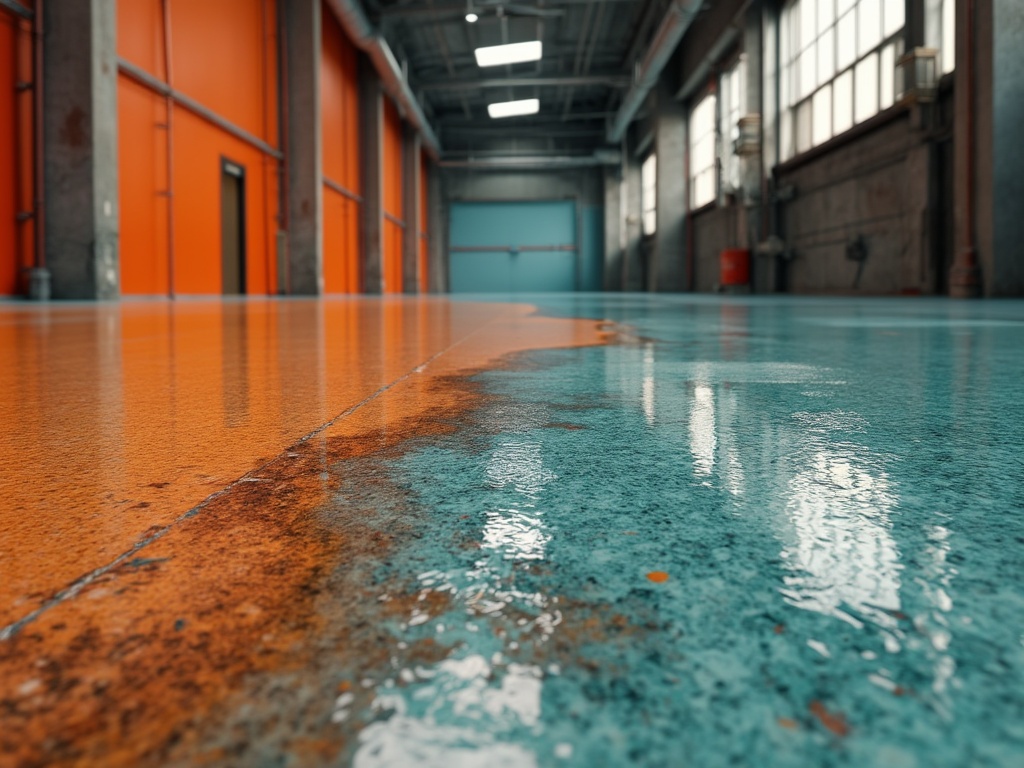
Homeowners and businesses in College Station are discovering the benefits of professionally prepared epoxy floors. The process begins with thorough cleaning and degreasing to remove contaminants that could affect adhesion.
Experts then repair any cracks or damage to create a smooth surface for the resin coatings.
Advanced techniques like diamond grinding or shot blasting profile the concrete, ensuring optimal bonding with the epoxy.
Surface preparation is crucial for achieving durable and attractive results.
Here are the key steps:.
- Cleaning and degreasing
- Repairing cracks and damage
- Profiling the concrete surface
- Moisture testing and mitigation
- Applying primer (if necessary)
These steps create an ideal foundation for the epoxy coating, resulting in floors that resist chemicals, withstand heavy use, and maintain their appearance for years. The concrete sealing process also helps prevent future moisture issues. While the initial investment may be higher than traditional flooring options, the long-term benefits include reduced maintenance and an extended lifespan, making epoxy floors a cost-effective choice for both residential and commercial spaces.
Click here to learn more about: collegestationepoxy.com
Surface Preparation: Key To Durability
Successful epoxy flooring projects begin with thorough cleaning and profiling of the substrate. Removing contaminants and creating a textured surface promote optimal adhesion and durability enhancement.
Addressing cracks and imperfections before application prevents future issues and ensures a smooth finish.
Various methods, such as shot blasting, grinding, and chemical etching, suit different substrate conditions.
- Shot blasting: Ideal for large areas and heavy-duty cleaning
- Grinding: Effective for leveling and smoothing concrete surfaces
- Chemical etching: Suitable for smaller areas or less porous substrates
Moisture content plays a crucial role in the preparation process. Excess moisture can compromise adhesion and lead to abrasion resistance issues. Different substrates may require tailored techniques to achieve the best results. College Station property owners who invest time in proper surface preparation can significantly extend the lifespan of their epoxy flooring and ensure long-lasting performance.
Once the surface is properly prepared, property owners can explore various epoxy flooring options, including decorative flakes and metallic pigments, to transform their spaces. The next step involves selecting the appropriate resin coatings to match the specific needs of the project.

Choosing The Right Resin Coatings
Floor protection solutions come in various forms, each offering unique benefits. Epoxy coatings stand out for their exceptional durability and resistance to chemicals, making them a top choice for industrial environments.
Polyurethane options excel in flexibility and UV stability, substrate evaluation making them suitable for outdoor applications.
Polyaspartic coatings boast quick curing times and can be applied at low temperatures, ideal for projects with tight deadlines.
- Industrial settings: Robust coatings capable of withstanding heavy machinery and chemical exposure
- Residential spaces: Visually appealing options that are easy to maintain
- Commercial areas: Striking a balance between longevity and aesthetic appeal
Project timelines, environmental factors, and budget considerations play a significant role in selecting the appropriate resin. Professional guidance ensures primer application optimal choices tailored to specific project requirements, resulting in durable and visually pleasing finishes. The right surface preparation sets the foundation for long-lasting results, while moisture barriers protect against potential damage from ground moisture.
Key Points About Floor Protection Solutions
- Epoxy coatings offer exceptional durability and chemical resistance
- Polyurethane options excel in flexibility and UV stability
- Polyaspartic coatings feature quick curing times and low-temperature application
- Professional guidance ensures optimal choices for specific project requirements
Moisture Barrier: Why It Matters
Flooring durability hinges on effective moisture management. Concrete substrates often conceal hidden moisture issues that can compromise flooring integrity over time.
Excess moisture leads to adhesive breakdown and coating delamination, causing significant damage and expensive repairs.
Proper vapor transmission prevention through effective barriers extends the lifespan of floor coatings and maintains their quality.
- Advantages of moisture barriers:
- Prevent floor failures
- Enhance coating longevity
- Boost indoor air quality
- Lower long-term maintenance expenses
Professional moisture testing is necessary before floor installation to accurately assess substrate moisture levels. Experts employ various methods to determine these levels, ensuring appropriate mitigation strategies are implemented. While initial investment in moisture mitigation may seem high, it offers significant long-term savings by preventing costly floor failures and extending the life of your flooring system. Proper mixing ratios and application techniques are essential for optimal performance of moisture barriers.
Non-Slip Additives For Safety Concerns
Enhancing traction remains a top priority when applying epoxy flooring, particularly in moisture-prone or high-traffic areas. Aluminum oxide and quartz emerge as premier options for boosting grip in diverse settings.
These materials not only augment safety but also enhance the overall longevity and durability of the flooring system, offering thermal shock protection in various environments.
Industrial environments reap significant advantages from aluminum oxide additives, which deliver essential traction in heavily traversed spaces.
Quartz strikes a balance between safety and aesthetics, making it particularly suitable for residential applications such as bathrooms and kitchens.
Selecting the appropriate grip-enhancing material hinges on factors including surface type, anticipated foot traffic, and desired visual appeal.
Expert consultation plays a pivotal role in choosing and implementing slip-resistant additives to achieve optimal outcomes and ensure antimicrobial properties. Proper application techniques involve uniform distribution of the materials throughout the epoxy mixture, ensuring consistent traction across the entire floor surface.
- Consistent upkeep is key to maintaining the efficacy of slip-resistant additives
- Scheduled evaluations may be necessary to determine if reapplication is needed
- Tailored cleaning protocols should preserve both safety features and visual appeal
While moisture barriers protect against underlying dampness, nonslip additives safeguard those walking on the surface. These safety-enhancing materials complement decorative elements like flakes or metallic pigments, allowing for both style and security in epoxy flooring solutions.
Decorative Flakes Or Metallic Pigments
Epoxy flooring systems gain a spectacular dimension through the incorporation of aesthetic elements. These enhancements bring life to ordinary surfaces, creating visually stunning and unique environments.
Beyond their color customization appeal, decorative additions contribute to the overall durability and longevity of the flooring system.
- Visual Impact:
- Flakes add depth, texture, and dimension to epoxy floors
- Pigments create flowing, iridescent effects reminiscent of marble or polished stone
Application techniques vary depending on the desired outcome. Flake broadcasting allows for different coverage levels, from sparse accents to full saturation. Metallic epoxy application requires skill to achieve swirling patterns and three-dimensional effects. Both options offer extensive color possibilities, allowing for personalized designs that complement any space while providing a glossy finish.
- Durability Considerations:
- Decorative additives can enhance the floor’s resistance to wear and tear
- Flaked surfaces may require slightly more maintenance than smooth epoxy finishes
Cost factors vary between flake and metallic options, with metallic finishes typically commanding a higher price point. The long-term value of these decorative epoxy floors often justifies the initial investment, providing both aesthetic appeal and functional benefits for years to come. The stain resistance of these surfaces ensures they maintain their beauty even in high-traffic areas.
UV Stability In Outdoor Installations
Durable outdoor installations demand superior protection against harsh environmental elements. Advanced epoxy coatings with ultraviolet-resistant properties offer exceptional safeguarding for exterior surfaces.
These innovative formulations significantly prolong the lifespan of outdoor structures by minimizing color fading and material deterioration.
Epoxy coatings provide outstanding resistance to weathering, ensuring sustained performance in diverse climates.
Patios, pool decks, and outdoor living spaces greatly benefit from these fastcuring formulas, as do commercial and industrial exterior flooring applications.
- Thorough surface preparation enhances adhesion and overall coating performance
- Choosing suitable UV-resistant formulations requires consideration of specific environmental conditions
- UV-resistant epoxy can lower maintenance expenses compared to conventional exterior coatings
- Progressive formulations combine UV protection with slip resistance for enhanced outdoor safety
Epoxy coatings with enhanced UV stability offer remarkable light reflectivity, contributing to energy efficiency in outdoor spaces. These coatings seamlessly blend aesthetics with functionality, complementing decorative flakes or metallic pigments used in previous installations. The durability and longevity of UV-stable epoxy coatings make them a cost-effective solution for various outdoor applications.
UV-Resistant Epoxy Coatings
- UV-resistant epoxy coatings can extend the lifespan of outdoor structures by up to 50%
- These coatings can reduce maintenance costs by 30-40% compared to traditional exterior finishes
- UV-stable epoxy coatings can reflect up to 80% of sunlight, improving energy efficiency
- Advanced formulations can withstand temperatures ranging from -40°F to 200°F (-40°C to 93°C)
Cost-Effectiveness Of Epoxy Flooring
Durable flooring solutions offer substantial savings throughout their lifespan. The resilience of epoxy in high-traffic areas contributes significantly to its economic advantage compared to alternative options.
Although the upfront investment may seem considerable, the enduring benefits frequently outweigh initial costs.
- Material and professional installation expenses are balanced by reduced replacement frequency
- Low maintenance requirements result in decreased ongoing costs
- Epoxy surfaces often outlast tile, hardwood, and carpet in various environments
Property values can increase with the addition of epoxy flooring, potentially boosting resale prices. Quality installation and materials used play vital roles in maximizing economic benefits. Environmental factors and usage patterns also influence the overall financial advantages of selecting epoxy for your flooring needs. The temperature resistance of epoxy contributes to its longevity, further enhancing its cost-effectiveness over time.
Maintenance Tips For Longevity
Epoxy flooring requires specific upkeep to preserve its pristine condition and functionality over time. Implementing proper care routines helps sustain the floor’s appeal and durability for years.
The following tips will help you maintain your epoxy flooring effectively:.
- Daily Maintenance: Sweep or dust mop frequently to remove grit and debris. Use pH-neutral cleaners for stubborn stains to ensure longevity.
- Long-term Care: Perform thorough cleaning quarterly. Evaluate the need for resealing every 3-5 years, based on wear patterns.
- Damage Prevention: Use protective mats in high-traffic zones and felt pads under furniture legs to avoid scratches.
- Professional Maintenance: Schedule yearly inspections with epoxy flooring specialists to address potential issues early.
Environmental factors may influence maintenance frequency. Coastal regions might need more regular cleaning due to salt air exposure. Proper care ensures cost-effectiveness by extending the floor’s lifespan and preserving its appearance. Consider eco-friendly options for cleaning products to minimize environmental impact while maintaining your epoxy flooring.
Epoxy Flooring Maintenance
- pH-neutral cleaners are recommended for preserving epoxy floor quality
- Resealing may be necessary every 3-5 years depending on wear patterns
- Coastal environments may require more frequent maintenance due to salt air exposure
- Annual professional inspections can help identify and address potential issues early
Industrial Floor Coatings Transform College Station Spaces
Epoxy Floor Colors Transform College Station Spaces
